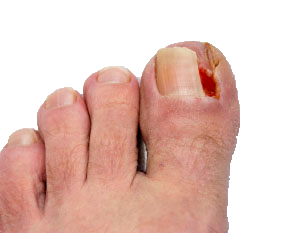Welcome to Tri-County Foot & Ankle
Ingrown Toenails

What Are Ingrown Toenails?
If you’ve ever experienced the pain and discomfort at the tip of your shoe while you walk or run, chances are you have an ingrown toenail. The condition of ingrown toenails is caused when a toenail grows sideways into the bed of the nail, causing pain and swelling. The nail can sometimes exacerbate and become infected, creating serious drainage. Ingrown toenails result when the corner of a nail grows into the soft flesh that surrounds it. While ingrown toenails may cause minimal pain at first, they can spread and worsen very quickly.
Causes
There are many risk factors that can predispose a person to this common condition. Cutting your nails too short, participating in sports, diabetes, being overweight, or having a fungal infection of the toe can all cause an ingrown toenail. The condition can often be related to genetics, as many people are genetically predisposed to ingrown nails. More often than not, the problem can arise from wearing ill-fitting shoes or from shoes that keep the feet slightly damp.
Treatments
Ingrown toenails can be preventable with certain measures. For starters, allowing your toe nails to grow slightly longer in length will help prevent them from becoming ingrown. If you have already developed an ingrown toenail, soak the affected toe in warm water. This will alleviate the pain and help prevent an infection from forming. Antibiotic soap or Epsom salts may be added to further help the relieving process and avoid infection. Placing cotton beneath the affected area is also suggested, as this may help the toenail grow upwards and not into the nail bed. Swelling and redness can be reduced by resting with your feet elevated. An ingrown toenail can be easily treated with a Band-Aid. Simply wrap the affected toe with a Band-Aid to prevent infection and keep the nail from growing out at a painful angle.
Because ingrown toenails are not something found outside of shoe-wearing cultures, going barefoot as often as possible will decrease the likeliness of developing ingrown toenails. Wearing proper fitting shoes and using proper cutting techniques will also help decrease your risk of developing ingrown toenails.
If your pain is so severe that it keeps you from everyday activities and that is progressively worsening, however, a visit to our Tri-County Foot & Ankle doctors at our office in The Villages® may be necessary. A podiatrist should be seen if the pain becomes so serious that it prevents you from doing your everyday activities. If a red streak running up your leg appears or if you suspect your infection has spread, contact a podiatrist immediately. Fast treatments can be undertaken to lessen your pain and have you walking comfortably.
In more serious cases, your podiatrist may decide to make a small incision to remove a portion of your toenail. To prevent the nail from growing back, medication will be placed directly into the nail bed. This procedure would be performed under local anesthesia and is a faster method to alleviate discomfort from an ingrown toenail. Post-procedure directions will have you stay off the affected foot for a day. Afterwards, normal activities can be resumed.
For videos that may be of additional interest to you, please visit our YouTube channel.
